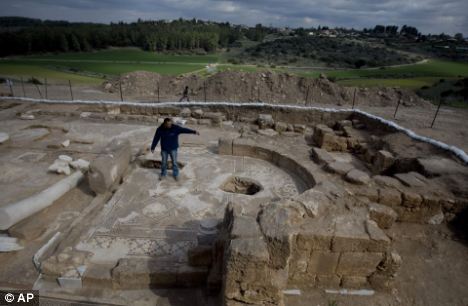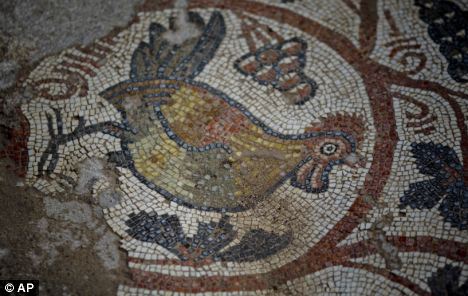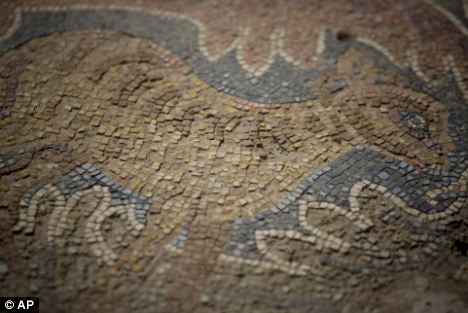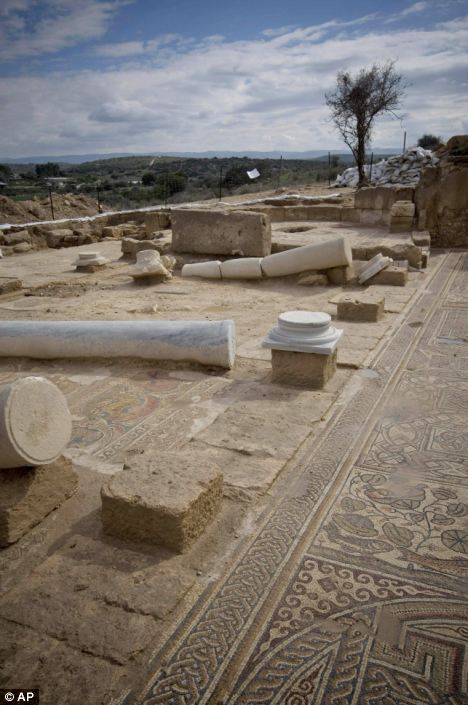Jerusalem, February 2, 2011
Archaeologists yesterday presented an ancient church they have discovered outside Jerusalem that may contain the burial place of the biblical prophet Zechariah.
The Byzantine church in the Judaean hills has an unusually well-preserved mosaic floor depicting lions, foxes, fish and peacocks.
It will be visible only for another week before it is covered again with soil for its own protection, said the dig's leader, Amir Ganor of the Israel Antiquities Authority.
 Hirbet Madras, Israel
Hirbet Madras, Israel
Discovery: Amir Ganor of thesrael Antiquities Authority shows a mosaic on the site of an ancient church at Hirbet Madras in the hills of central Israel
The hill-top church was destroyed by an earthquake some 1,300 years ago and lay partly buried until detectives from the authority, pursuing a gang of antiquity thieves, noticed an elaborate doorpost poking through the earth.
The robbers got away - they were caught a few months later at a site nearby - but archaeologists began digging at the site, known as Hirbet Madras, in December and eventually uncovered the remains of the church.
It was about the size of a basketball court and contained fallen marble pillars and the nearly pristine 10-metre-long mosaic.
Beneath the church's altar is a burial chamber that the Antiquities Authority said may have been the tomb of the prophet Zechariah, known from the eponymous book in the Bible, written around 520 BC, which tells of the Jews return from exile in Babylon and the rebuilding of the Temple.
The claim that it was Zechariah's last resting place, which a number of experts have based on Christian sources and an ancient church mosaic showing the Holy Land known as the Madaba Map, has not been proved and is still being studied.
'It's been years since we've made a find like this,' said Amir Ganor, head of the Antiquities Robbery Prevention unit. 'The floor is one of the most beautiful mosaics to be uncovered in Israel in recent years, unique in its craftsmanship and level of preservation.'
 chicken mosaic Hirbet Madras, central Israel
chicken mosaic Hirbet Madras, central Israel
Find: A chicken in a mosaic on the floor of an ancient church at Hirbet Madras
 lamb mosaic Hirbet Madras, central Israel.
lamb mosaic Hirbet Madras, central Israel.
A lamb pictured in the mosaic at the church in the hills southwest of Jerusalem
Ganor is an archaeologist who carries a handgun. His team spends much of its time trying to catch thieves, spending nights lying in ambush or setting up stings for crooked antiquities dealers.
The thieves often vandalize or destroy archaeological remains before Ganor's unit can catch them.
But in this case, he said, a group of Palestinians from the West Bank who were plundering ancient coins revealed the location of the lost church, some 25 miles south of Jerusalem.
Shai Bartura, Ganor's deputy, said the building, which was used between the 5th and 7th Century AD, was a unique discovery because of its size and good condition.
Like many ancient structures, it was built on even older foundations dating back to the Roman Empire and the period of the second Jewish Temple.
Though a first survey suggested the building was a synagogue, the excavation revealed stones carved with crosses.
The building is atop another structure 500 years older, thought to have been Jewish; hewn into the rock underneath is a network of tunnels that archaeologists believe were used by Jewish rebels fighting Roman armies in the Bar Kokhba revolt of 132 AD.
Stone steps lead down from the floor of church to a small burial cave, which, it is suggested, might have been venerated as the burial place of the Old Testament prophet Zechariah.
 Hirbet Madras, Israel
Hirbet Madras, Israel
